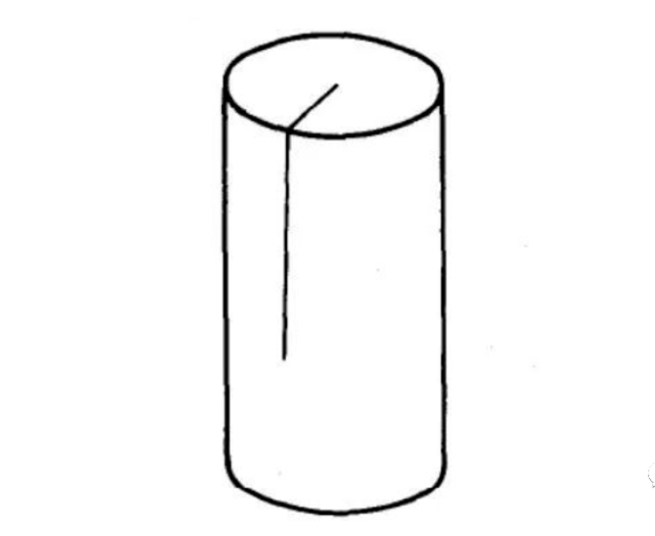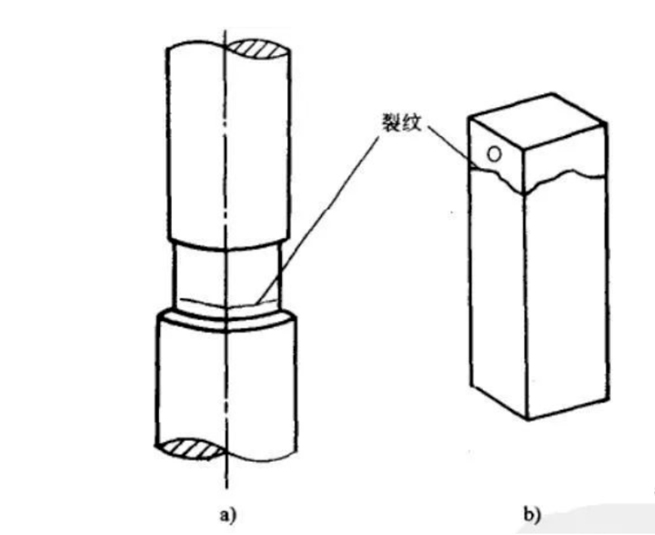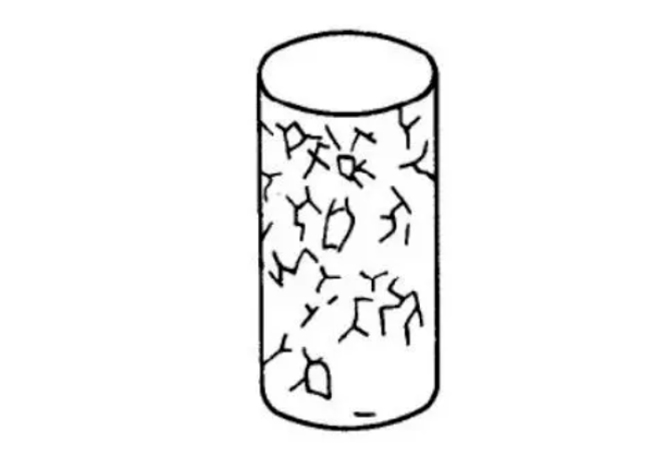The crack is axial and has a thin and long shape. When the die is fully quenched, that is, centerless quenching, the center is transformed into quenched Martensite with the largest specific volume, generating tangential tensile stress. The higher the carbon content of the die steel, the greater the tangential tensile stress generated. When the tensile stress is greater than the strength limit of the steel, longitudinal cracks are formed. The following factors further exacerbate the generation of longitudinal cracks:

(1) Steel contains a large amount of low melting point harmful impurities such as S, P, Bi, Pb, Sn, As, etc. When rolling the steel ingot, it exhibits a severe longitudinal segregation distribution along the rolling direction, which is prone to stress concentration and formation of longitudinal quenching cracks, or the longitudinal cracks formed by rapid cooling of raw materials after rolling are not processed and retained in the product, leading to the expansion of the final quenching cracks and the formation of longitudinal cracks;
(2) Longitudinal cracks are easily formed when the die size is within the range of quenching crack sensitive size of steel (the dangerous size of quenching crack of carbon Tool steel is 8~15mm, and the dangerous size of medium and low alloy steel is 25~40mm) or the selected quenching cooling medium greatly exceeds the critical quenching cooling speed of the steel.
Preventive measures:
(1) Strictly inspect the storage of raw materials, and do not put into production steel with excessive harmful impurity content; (2) Vacuum smelting, furnace refining or Electro-slag remelting die steel shall be selected as far as possible; (3) Improve the heat treatment process by using vacuum heating, protective atmosphere heating, and fully deoxidized salt bath furnace heating, as well as graded quenching and isothermal quenching; (4) Changing from centerless quenching to central quenching, i.e. incomplete quenching, and obtaining lower Bainite structure with high strength and toughness, can significantly reduce the tensile stress and effectively avoid longitudinal cracking and quenching distortion of the die.
The crack feature is perpendicular to the axial direction. Unquenched molds have large tensile stress peaks in the transition between the quenched and unhardened areas. When large molds are rapidly cooled, large tensile stress peaks are easily formed, as the axial stress formed is greater than the tangential stress, leading to transverse cracks. The transverse segregation of harmful impurities with low melting points such as S, P, Bi, Pb, Sn, As in the forging module or the presence of transverse microcracks in the module, which propagate and form transverse cracks after quenching.

Preventive measures:
(1) The module should be forged reasonably, and the ratio of raw material length to diameter, i.e. the forging ratio, is best selected between 2-3. The forging adopts a double cross shaped variable direction forging, and after five upsets and five draws and multiple fires forging, the carbides and impurities in the steel are fine and small, evenly distributed on the steel substrate. The forged fiber structure is not oriented around the mold cavity, greatly improving the transverse mechanical properties of the module, reducing and eliminating stress sources;
(3) Select the ideal cooling rate and cooling medium: fast cooling above the Ms point of the steel, which is greater than the critical quenching cooling rate of the steel. The stress produced by the undercooled austenite in the steel is thermal stress, the surface stress is compressive stress, and the inner stress is tensile stress, which offset each other, effectively preventing the formation of thermal stress cracks. Slow cooling between Ms and Mf of the steel can significantly reduce the structural stress when quenching Martensite is formed. When the sum of thermal stress and corresponding stress in steel is positive (tensile stress), it is easy to crack, and when it is negative, it is not easy to crack. By fully utilizing thermal stress, reducing phase transformation stress, and controlling the total stress to be negative, transverse quenching cracks can be effectively avoided. CL-1 organic quenching medium is an ideal quenching agent, which can reduce and avoid quenching mold distortion, and can also control the reasonable distribution of the hardening layer. Adjusting the different concentration ratios of CL-1 quenchant can obtain different cooling rates and obtain the required distribution of hardening layers to meet the needs of different mold steels.
It often occurs at sudden changes in the shape of mold corners, notches, holes, and concave mold wire flash. This is because the stress generated at the edges and corners during quenching is 10 times the average stress on a smooth surface.
(1) The higher the carbon (C) content and alloying element content in the steel, the lower the Ms point of the steel. If the Ms point decreases by 2 ℃, the tendency for quenching cracking increases by 1.2 times, the Ms point decreases by 8 ℃, and the tendency for quenching cracking increases by 8 times;
(2) The difference in the transformation of different structures and the same structure in steel results in huge structural stress due to the tolerance of different structural ratios, leading to the formation of arc-shaped cracks at the interface of the structures;
(3) After quenching, the residual austenite in the steel is not fully transformed due to delayed tempering or insufficient tempering, which is retained in the service state to promote the redistribution of stress, or when the mold is in service, the residual austenite undergoes Martensite transformation and generates new internal stress. When the comprehensive stress is greater than the strength limit of the steel, an arc-shaped crack will be formed;
(4) Having the second type of tempered brittle steel, it undergoes high-temperature tempering and slow cooling after quenching, causing harmful impurity compounds such as P and s to precipitate along grain boundaries, greatly reducing grain boundary bonding force and strength toughness, increasing brittleness, and forming arc shaped cracks under external forces during service.
Preventive measures:
(1) Improve the design, try to make the shape symmetrical as much as possible, reduce shape mutations, increase process holes and reinforcing ribs, or use combination assembly;
(2) Rounded corners replace right angles and sharp edges, and through holes replace blind holes, improving machining accuracy and surface smoothness, reducing stress concentration sources. For areas where it is impossible to avoid right angles, sharp edges, blind holes, etc., the general hardness requirements are not high. Iron wire, asbestos rope, refractory mud, etc. can be used to wrap or fill, artificially creating a cooling barrier to slowly cool and quench, avoiding stress concentration, and preventing the formation of arc shaped cracks during quenching;
(3) Quenched steel should be tempered in a timely manner to eliminate some of the quenching internal stress and prevent the expansion of quenching stress;
(4) Temper for a long time to improve the Fracture toughness of the die;
(5) Fully tempered to obtain stable microstructure and properties; Multiple tempering can fully transform residual austenite and eliminate new stresses;
Reasonable tempering to improve the fatigue resistance and comprehensive mechanical properties of steel parts; For the second type of tempered brittle mold steel, it should be quickly cooled (water cooled or oil cooled) after high-temperature tempering to eliminate the second type of tempered brittleness and prevent and avoid the formation of arc shaped cracks during quenching.
During the service of the mold, under the action of stress, the hardened layer peels off one by one from the steel matrix. Due to the different specific volume of the surface structure and the central structure of the mold, the axial and tangential quenching stress is formed on the surface during quenching, and the tensile stress is generated in the radial direction, and it suddenly changes to the interior. Peel cracks are generated at the narrow area where the stress changes sharply, which often occur during the cooling process of the mold after surface chemical heat treatment. Because the chemical modification of the surface layer is different from the transformation of the steel matrix, the expansion of the quenched martensite in the inner and outer layers is different, resulting in large transformation stress, Causing the chemical treatment infiltration layer to peel off from the matrix structure. Such as flame surface hardening layer, high-frequency surface hardening layer, carburizing layer, carbonitriding layer, nitriding layer, boronizing layer, and metallizing layer. After quenching, rapid tempering is not suitable for the chemical infiltration layer, especially for low-temperature tempering below 300 ° C and rapid heating, which can promote the formation of tensile stress on the surface layer, while compressive stress is formed in the core and transition layer of the steel matrix. When the tensile stress is greater than the compressive stress, it can cause the chemical infiltration layer to be pulled apart and peeled off.
Preventive measures:
(1) The concentration and hardness of the chemical infiltration layer on the mold steel should be gradually reduced from the surface to the inside, enhancing the bonding force between the infiltration layer and the substrate. Diffusion treatment after infiltration can make the transition between the chemical infiltration layer and the substrate uniform;
(2) Before chemical treatment of mold steel, diffusion annealing, spheroidizing annealing, and quenching and tempering treatment are carried out to fully refine the original structure, effectively preventing and avoiding the generation of peeling cracks, and ensuring product quality.
The depth of the crack is relatively shallow, usually about 0.01-1.5mm deep, and it is radiating, also known as cracking.

The main reasons are:
(1) The raw material has a deep decarburization layer that has not been removed during cold cutting, or the finished mold is heated in an oxidation atmosphere furnace, resulting in oxidation decarburization;
(2) The metal structure of the decarburized surface layer of the die is different from the carbon content of the steel matrix Martensite, and the specific volume is different. When the decarburized surface layer of the steel is quenched, a large tensile stress is generated. Therefore, the surface metal is often cracked into a network along the grain boundary;
(3) The raw material is coarse-grained steel, with a coarse original structure and large blocks of ferrite that cannot be eliminated by conventional quenching. It remains in the quenched structure, or temperature control is not accurate, resulting in instrument failure, overheating or even burning of the structure, coarsening of the grains, and loss of grain boundary bonding force. During mold quenching and cooling, carbides in the steel precipitate along the austenite grain boundaries, greatly reducing grain boundary strength, poor toughness, and high brittleness, Under tensile stress, it cracks in a network along grain boundaries.
Preventive measures:
(1) Strictly control the chemical composition, metallographic structure, and flaw detection of raw materials. Unqualified raw materials and coarse grain steel should not be used as mold materials;
(2) Select fine-grained steel and vacuum electric furnace steel, and recheck the depth of decarburization layer of raw materials before production. The cold cutting allowance must be greater than the depth of decarburization layer;
(3) Develop advanced and reasonable heat treatment processes, select microcomputer temperature control instruments, achieve control accuracy of ± 1.5 ℃, and regularly calibrate the instruments on site;
(4) The final treatment of the mold product adopts measures such as vacuum electric furnace, protective atmosphere furnace, and fully deoxidized salt bath furnace to heat the mold product, effectively preventing and avoiding the formation of network cracks.